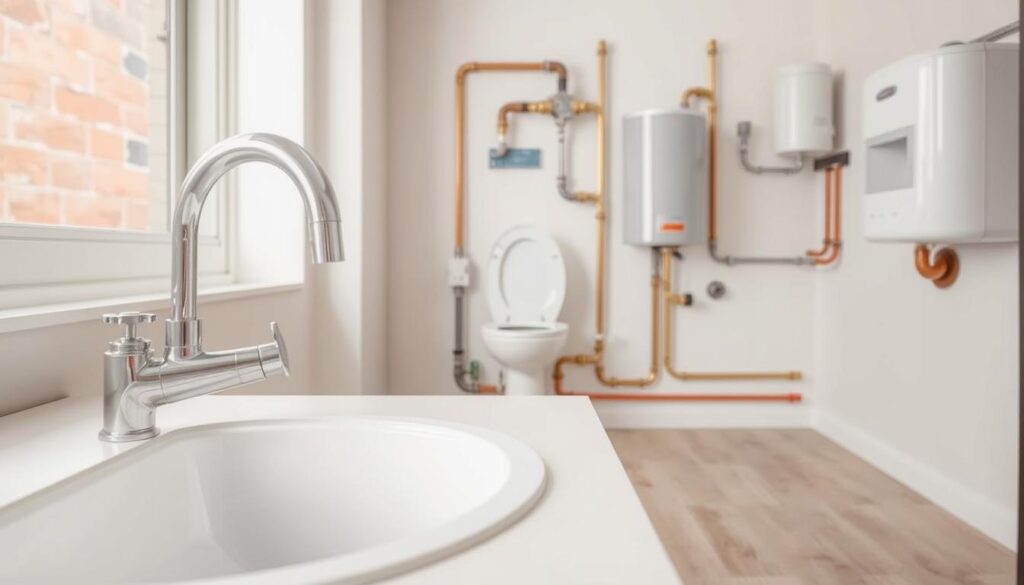As a homeowner, dealing with leaky faucets and clogged drains can be frustrating and costly. Understanding the basics of plumbing can help you tackle these common issues and prevent more significant problems from arising. By learning essential plumbing advice, you can save money on repairs and ensure your home’s plumbing system operates efficiently.
Having a well-maintained plumbing system is crucial for any home. It not only ensures the comfort and safety of your family but also protects your property from potential water damage. By grasping the fundamentals of plumbing, you can identify potential issues before they become major problems.
Key Takeaways
- Understand the importance of regular plumbing maintenance.
- Learn how to identify common plumbing issues.
- Discover DIY plumbing repairs to save money.
- Know when to call a professional plumber.
- Optimize your home’s water pressure for efficient operation.
Understanding Your Plumbing System
Understanding the intricacies of your home’s plumbing system can save you from potential headaches and costly repairs down the line. A plumbing system is not just a collection of pipes; it’s a complex network that requires maintenance and understanding to function correctly.
What Is a Plumbing System?
A plumbing system is designed to distribute clean water throughout your home and remove wastewater. It’s a vital part of your home’s infrastructure, ensuring that you have access to clean water for drinking, cooking, and hygiene, while also safely disposing of waste.
“A well-functioning plumbing system is crucial for the health and comfort of a household.” This statement underscores the importance of having a properly functioning plumbing system. It’s not just about convenience; it’s also about health and safety.
Components of a Plumbing System
The core components of a residential plumbing system include the water supply system and the drain-waste-vent (DWV) system. The water supply system brings clean water into your home, while the DWV system removes wastewater and provides ventilation to prevent siphoning of traps.
- Pipes: These are the channels through which water is distributed and wastewater is removed.
- Fixtures: Sinks, toilets, and showers are examples of fixtures that are connected to the plumbing system.
- Venting Systems: These are crucial for preventing the siphoning of traps and ensuring that wastewater flows freely.
The harmony between these components is what makes a plumbing system effective. Understanding how they work together is key to maintaining your home’s plumbing.
By grasping the basics of your plumbing system, you can better diagnose issues, perform routine maintenance, and know when to call a professional. This knowledge empowers homeowners to take control of their plumbing, potentially saving time and money.
Common Plumbing Problems
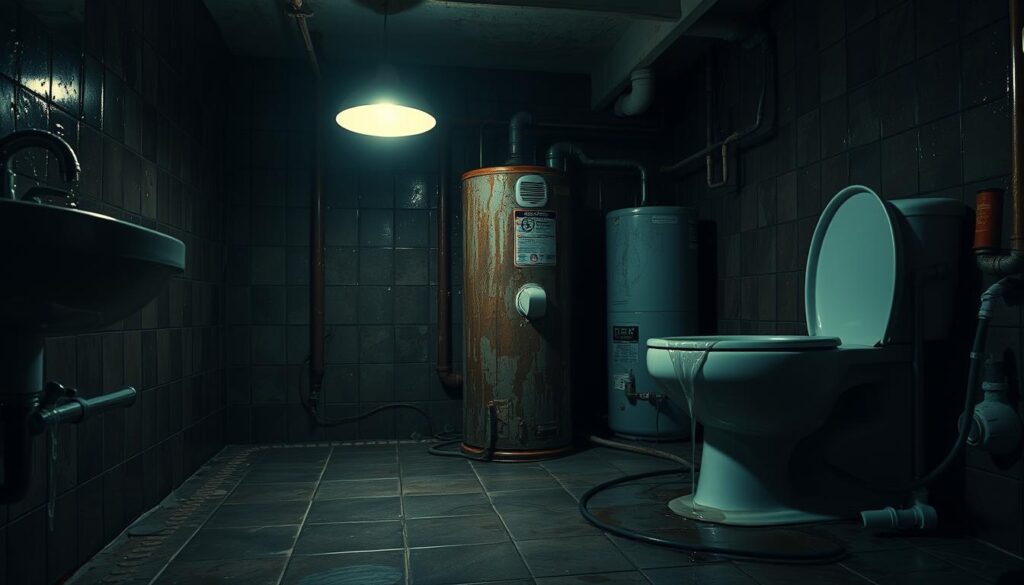
Common plumbing problems, such as leaky faucets and running toilets, are not only annoying but can also lead to significant water waste and increased utility bills. Understanding these issues and knowing how to fix them can save homeowners money and prevent further damage.
Leaky Faucets and Their Causes
A leaky faucet is one of the most common plumbing problems. The causes can vary, but often it’s due to worn-out or damaged O-rings, gaskets, or valve seats. To fix a leaky faucet, one may need to replace these parts or tighten loose components.
Steps to Fix a Leaky Faucet:
- Turn off the water supply to the faucet.
- Disassemble the faucet to identify the source of the leak.
- Replace or repair the damaged parts.
- Reassemble the faucet and turn on the water supply.
Running Toilets: Diagnosis and Fix
A running toilet can waste a significant amount of water. The issue is often related to the flapper or fill valve. Diagnosing the problem involves checking the flapper for proper sealing and ensuring the fill valve is functioning correctly.
To fix a running toilet:
- Check the flapper and replace it if necessary.
- Adjust or replace the fill valve to ensure proper water level.
Clogged Drains: Prevention and Solutions
Clogged drains are another common issue. Prevention involves being mindful of what goes down the drain. Using drain screens and avoiding pouring grease or large food particles can help.
To clear a clogged drain:
- Use a plunger or plumbing snake to remove the blockage.
- For tougher clogs, consider using a chemical drain cleaner or calling a professional.
Essential Plumbing Tools for Homeowners
Every homeowner should be equipped with basic plumbing tools to handle common issues effectively. Having the right tools on hand can make a significant difference in addressing minor plumbing problems before they escalate into major repairs.
Must-Have Tools for Basic Repairs
To tackle basic plumbing repairs, homeowners should have a set of fundamental tools. These include:
- A plunger for unclogging drains and toilets
- A pipe wrench for gripping and twisting pipes
- Plumber’s tape for creating watertight seals
- A hand auger for clearing clogs deeper in the drain system
These tools are essential for DIY plumbing maintenance for beginners, allowing homeowners to address common issues such as leaky faucets and clogged drains.
When to Call a Professional
While having the right tools is crucial, knowing when to call a professional plumber is equally important. Complex issues such as main line clogs, water heater malfunctions, or gas line leaks require the expertise of a licensed plumber.
| Issue | DIY Solution | Professional Required |
|---|---|---|
| Leaky Faucet | Yes, with basic tools | No, unless complex |
| Clogged Drain | Yes, with a plunger or auger | No, unless main line |
| Water Heater Issues | No | Yes, for safety and efficiency |
Understanding when to attempt a DIY fix and when to call a professional is a key aspect of effective plumbing maintenance. By being equipped with the right tools and knowledge, homeowners can save time and money, ensuring their plumbing system operates smoothly.
Preventative Maintenance Tips
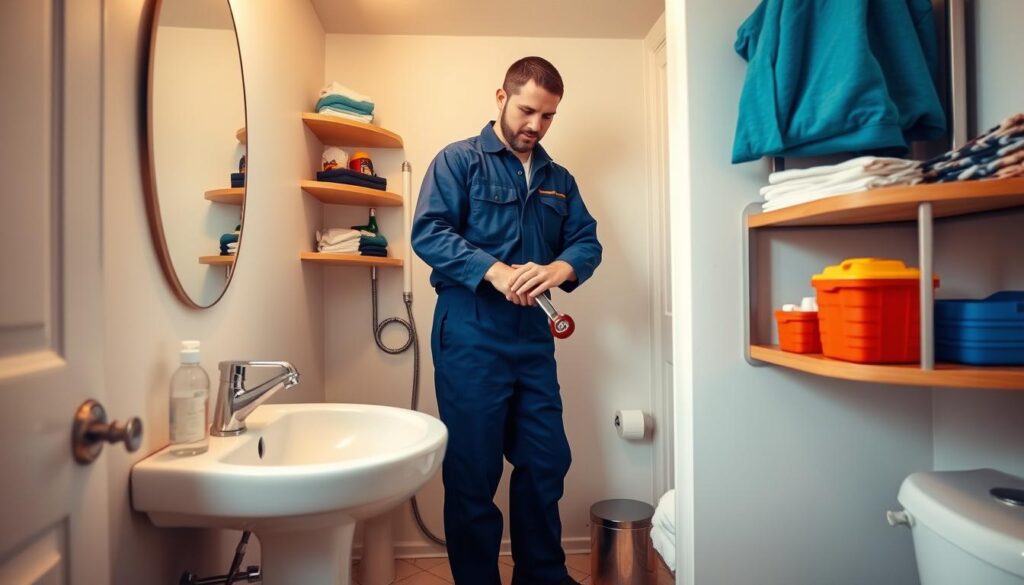
Preventative maintenance is key to extending the lifespan of your plumbing system and avoiding unexpected breakdowns. By taking proactive steps, homeowners can identify potential issues before they become major problems.
How to Maintain Your Pipes
Maintaining your pipes involves regular inspections and simple maintenance tasks. Start by checking your pipes for signs of corrosion, leaks, or damage. Avoid using harsh chemical drain cleaners, as they can damage your pipes over time. Instead, consider using natural alternatives or plumbing snakes to clear clogs.
Regular Inspection Tips
Regular inspections are crucial for detecting potential issues early. Check your plumbing system for signs of wear, such as rust or mineral buildup. Inspect your water heater, faucets, and toilets for leaks or other issues. For more detailed guidance, you can refer to resources like Amica’s preventive plumbing tips.
| Maintenance Task | Frequency | Benefits |
|---|---|---|
| Inspect pipes for corrosion | Annually | Prevents leaks and damage |
| Check for leaks | Quarterly | Saves water and reduces bills |
| Avoid harsh chemical drain cleaners | Ongoing | Extends pipe lifespan |
By following these preventative maintenance tips, homeowners can ensure their plumbing system remains in good condition, reducing the risk of costly repairs and enhancing the overall safety and comfort of their home.
Water Pressure Issues
Water pressure problems can manifest in various ways, affecting your daily life and plumbing infrastructure. Maintaining the right water pressure is crucial for the efficient functioning of your home’s plumbing system.
Signs of Low Water Pressure
Low water pressure can be a significant inconvenience, making everyday tasks like showering or washing dishes frustrating. Signs of low water pressure include weak flow from faucets, toilets that take a long time to refill, and appliances that don’t function properly. Several factors can contribute to low water pressure, such as clogged or corroded pipes, improper pipe sizing, or issues with the municipal water supply.
To diagnose low water pressure, homeowners can start by checking for leaks or blockages in their plumbing system. It’s also essential to inspect the pressure regulator, if installed, to ensure it’s functioning correctly. For more complex issues, consulting a professional plumber is advisable to determine the root cause and implement the necessary fixes.
Fixing High Water Pressure Problems
On the other end of the spectrum, high water pressure can be just as problematic, potentially leading to leaks, burst pipes, and damage to appliances. Common signs of high water pressure include banging or clanging noises in the pipes, leaking faucets, and excessive wear on plumbing fixtures. High water pressure can be caused by a variety of factors, including thermal expansion, faulty pressure regulators, or overly powerful municipal water supply.
To address high water pressure, homeowners can consider installing a pressure-reducing valve. Regularly checking the water pressure using a pressure gauge can also help identify if the pressure is within a safe range (typically between 30-80 psi). For detailed guidance on the right water pressure for your home, you can refer to resources like Horizon Services, which provides valuable insights into managing water pressure.
“Proper water pressure is key to a well-functioning plumbing system. Too little pressure can lead to poor performance, while too much can cause damage.”
By understanding the causes of water pressure issues and knowing how to address them, homeowners can prevent damage to their plumbing system and ensure a safe and efficient water supply.
The Importance of Drainage
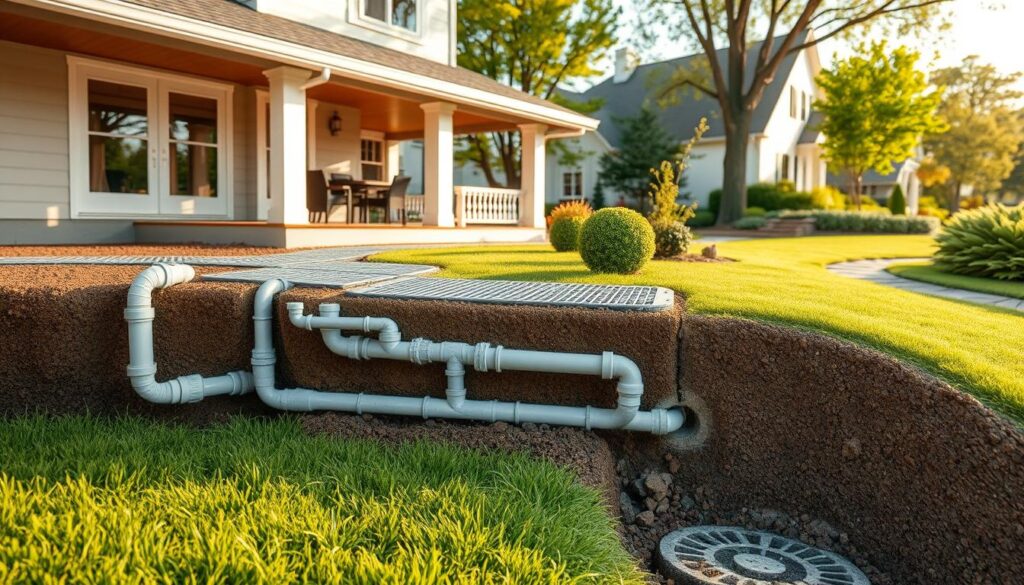
A well-functioning drainage system is crucial for maintaining a healthy and safe home environment. It plays a vital role in removing wastewater and preventing potential hazards such as water damage and mold growth.
Drainage systems work by utilizing gravity and venting to efficiently remove wastewater from homes. The venting system is particularly important as it allows air to enter the drainage system, preventing siphoning of water from traps and ensuring that wastewater flows freely.
How Drainage Systems Work
The mechanism behind drainage systems is based on the principle of gravity, where wastewater flows downwards through pipes. Venting is a critical component, as it prevents the formation of a vacuum that could hinder the flow of wastewater. “A properly designed drainage system is essential for the health and safety of a home’s occupants,” as noted by plumbing experts.
For homeowners looking to understand top plumbing tools and pipes for DIY, knowledge of how drainage systems work can be particularly useful.
Maintaining Your Home’s Drainage
Regular maintenance is key to ensuring that your drainage system functions correctly. This includes checking for blockages, ensuring proper venting, and inspecting pipes for signs of wear or damage. Homeowners can take several steps to maintain their drainage systems, such as avoiding the disposal of grease and large debris down drains and periodically inspecting their plumbing system.
By understanding the basics of drainage systems and taking proactive steps to maintain them, homeowners can prevent many common plumbing issues. Effective drainage is not just about removing wastewater; it’s also about protecting your home from potential damage.
Tips for Maintaining Your Drainage System:
- Regularly inspect your drains for signs of blockages or slow draining.
- Ensure that your venting system is clear and functioning properly.
- Avoid pouring grease or large debris down your drains.
- Consider periodic inspections by a professional plumber.
By following these tips and understanding how your drainage system works, you can help ensure that your home remains safe and free from plumbing-related issues.
DIY Plumbing Repair Basics
Homeowners can benefit greatly from learning basic DIY plumbing repair techniques. Not only can it save money, but it also empowers individuals to handle minor plumbing issues on their own.
When to DIY vs. Call a Plumber
Before attempting any DIY plumbing repair, it’s crucial to assess whether the task is within your skill level. Simple tasks like fixing a leaky faucet or unclogging a drain can often be handled with basic tools and some guidance. However, more complex issues such as main line clogs or water heater replacements typically require professional expertise.
- DIY-friendly tasks: Leaky faucets, clogged drains, running toilets
- Tasks requiring a professional: Main line clogs, water heater issues, complex pipe repairs
For more information on basic plumbing repairs, you can visit https://hi-spec.com/blogs/news/basic-plumbing-repairs-every-homeowner-should-know to learn about common fixes every homeowner should know.
Step-by-Step Guide to Fixing Leaks
Fixing leaks is one of the most common DIY plumbing tasks. Here’s a simple step-by-step guide:
- Turn off the water supply to the affected area.
- Disassemble the faucet to locate the source of the leak.
- Replace worn-out parts such as O-rings or gaskets.
- Reassemble the faucet and turn on the water supply.
By following these steps, homeowners can fix minor leaks and prevent water waste. Remember, if the leak persists or is coming from a complex fixture, it’s best to consult a professional plumber.
Winterizing Your Plumbing
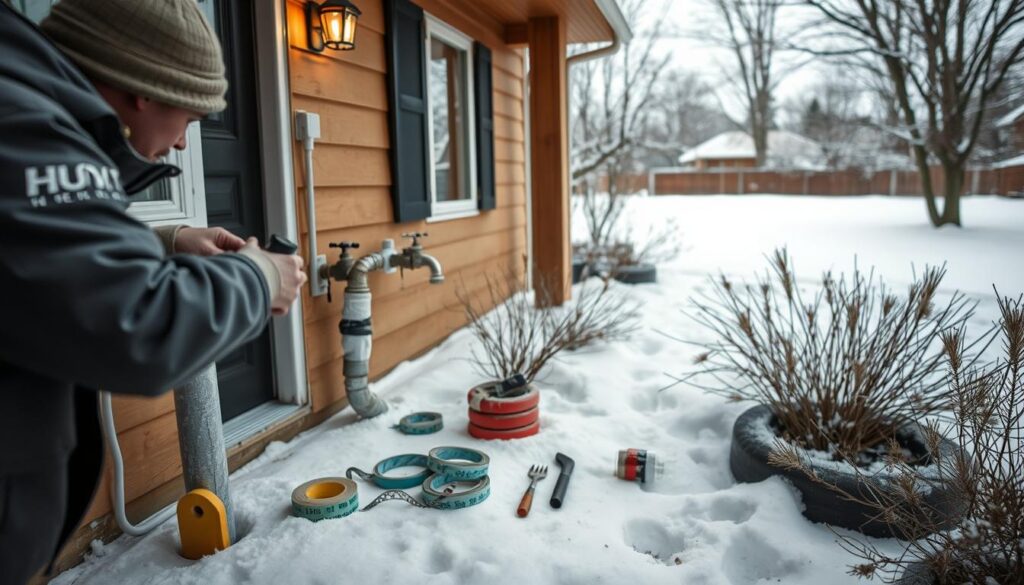
Winterizing your plumbing is a crucial step in preparing your home for the cold weather. This process involves several key measures to protect your plumbing system from freezing temperatures, which can cause significant damage.
Preparing for Cold Weather
To prepare your plumbing for winter, start by insulating exposed pipes in unheated areas like the garage, basement, or crawlspace. You can use foam pipe insulation or wrap pipes with heat tape or thermostatically controlled heat cables. For more detailed guidance, visit preparing your home for winter for additional tips.
Sealing drafts around doors, windows, and any openings for pipes and electrical outlets can also help keep cold air from reaching your pipes. This simple step can significantly reduce the risk of freezing.
Preventing Pipe Freezing
One effective way to prevent pipe freezing is by letting faucets drip during extremely cold weather. Running a small trickle of water through the faucet can relieve pressure in the pipes and prevent them from freezing. It’s also a good idea to disconnect and drain hoses from outdoor faucets to prevent water from freezing in the hoses.
For additional protection, consider installing freeze-proof faucets or frost-proof spigots, especially if you live in an area prone to harsh winters. For trusted solutions on plumbing repairs and maintenance, you can consult professionals like those at 24-7 Construction & Repair.
By taking these steps, you can help ensure your plumbing system remains safe and functional throughout the winter months. Remember, a little preparation can go a long way in preventing costly repairs down the line.
Understanding Water Quality
Understanding the quality of your home’s water is essential for ensuring a safe and healthy living environment. Water quality can be affected by various factors, including the source of the water, the condition of the plumbing system, and external environmental factors.
Common Water Quality Issues
Common water quality issues include contamination from lead pipes or bacterial growth. Lead contamination can occur when water passes through old lead pipes or fixtures, posing serious health risks, especially to children and pregnant women. Bacterial growth can happen in stagnant water or when the water treatment process is inadequate.
As noted by water quality experts, “Ensuring the quality of drinking water is crucial for public health.” Homeowners can take proactive steps to identify and mitigate these issues.
How to Test Water Quality at Home
Homeowners can test water quality using DIY kits or by hiring a professional. DIY kits are available at most hardware stores and can test for various contaminants, including lead, bacteria, and nitrates. For a more comprehensive analysis, hiring a certified water quality testing professional is recommended.
For detailed guidance on maintaining water quality, homeowners can refer to resources such as tips to maintain water quality in the. These resources provide valuable information on how to ensure safe drinking water and maintain a healthy plumbing system.
Regular testing and maintenance are key to ensuring good water quality. By understanding the common issues that can affect water quality and taking proactive steps to test and maintain it, homeowners can protect their health and the integrity of their plumbing system.
Smart Water Management Solutions
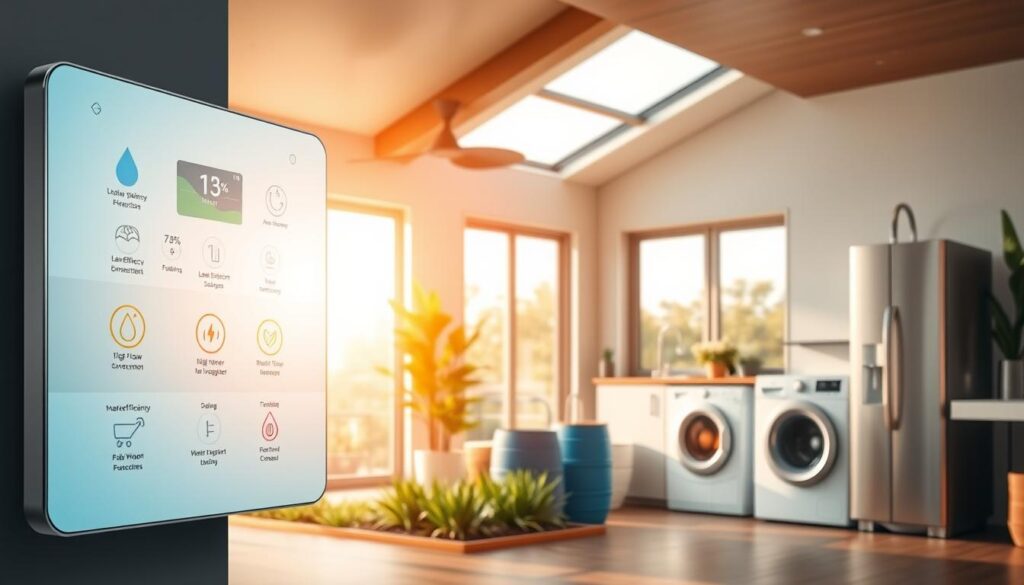
Smart water management is revolutionizing the way we conserve water at home. By integrating technology with traditional plumbing systems, homeowners can now monitor and control their water usage more effectively.
Benefits of Water Saving Fixtures
Water-saving fixtures are a crucial component of smart water management. These fixtures, including low-flow showerheads and toilets, are designed to reduce water consumption without compromising performance. By installing such fixtures, homeowners can significantly lower their water bills and contribute to water conservation efforts.
The benefits of water-saving fixtures extend beyond just financial savings. They also play a critical role in reducing the strain on local water resources, making them an environmentally friendly choice for homeowners.
Installing a Smart Water Meter
A smart water meter is another essential tool in smart water management. It provides real-time data on water usage, helping homeowners identify areas of inefficiency and detect leaks early. This not only saves water but also prevents potential damage to the home.
Installing a smart water meter is a straightforward process that can be done by a professional plumber. Once installed, it offers a wealth of information that can be used to make informed decisions about water usage.
By embracing smart water management solutions, homeowners can take a proactive approach to water conservation. It’s a step towards a more sustainable future, and with the right plumbing tips and tricks, it’s easier than ever to get started.
Handling Emergencies
Plumbing emergencies, such as burst pipes, demand immediate action to prevent extensive water damage. Knowing how to respond can make a significant difference in minimizing damage and ensuring safety.
Tips for Dealing with Plumbing Emergencies
When faced with a plumbing emergency, it’s essential to remain calm and act quickly. First, identify the source of the problem. For instance, if you have a burst pipe, locating the main shut-off valve and turning it off can stop further water damage. For other emergencies like leaky faucets or overflowing toilets, turning off the water supply to the specific fixture can mitigate the issue.
For more complex issues or if you’re unsure about how to proceed, consider seeking professional help. You can find emergency plumbing services that can provide immediate assistance.
How to Shut Off Your Water Supply
Understanding how to shut off your water supply is crucial in a plumbing emergency. The main shut-off valve is typically located near the water meter or where the water line enters your home. It’s essential to familiarize yourself with its location and operation before an emergency occurs.
To shut off the water supply, turn the valve clockwise. It’s also a good idea to check your shut-off valve periodically to ensure it’s functioning correctly. In some cases, you might need to shut off the water supply to a specific fixture, such as under the sink for a leaky faucet.
Eco-Friendly Plumbing Options
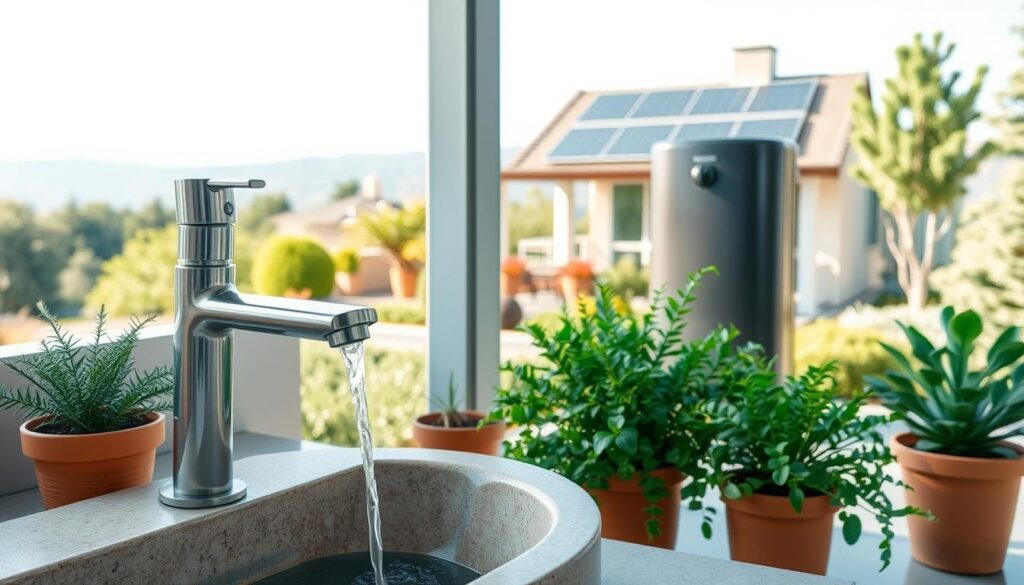
The shift towards eco-friendly plumbing options is driven by the need to conserve water and reduce utility bills. Homeowners are increasingly looking for sustainable solutions that not only benefit the environment but also save them money in the long run.
Green Plumbing Solutions
Green plumbing solutions encompass a range of technologies and practices designed to reduce water consumption and promote sustainability. Some of the key solutions include:
- Low-flow fixtures that reduce water usage without compromising performance.
- Greywater reuse systems that recycle water from sinks, showers, and washing machines for irrigation and flushing toilets.
- Rainwater harvesting systems that collect and store rainwater for various uses.
These solutions are not only beneficial for the environment, but they also contribute to lower utility bills, making them a cost-effective choice for homeowners.
Benefits of Eco-Friendly Fixtures
Eco-friendly fixtures offer numerous benefits, including reduced water consumption, lower utility bills, and a decreased environmental footprint. Some of the most effective eco-friendly fixtures include:
| Fixture | Water Savings | Benefits |
|---|---|---|
| Low-flow showerheads | Up to 2.5 gallons per minute | Reduces water heating costs |
| Dual-flush toilets | Up to 1.6 gallons per flush | Saves water with each use |
| Low-flow faucets | Up to 1.5 gallons per minute | Reduces water waste |
By incorporating these fixtures into their plumbing systems, homeowners can significantly reduce their water consumption and contribute to a more sustainable future.
Eco-friendly plumbing is a step towards a more sustainable home. By adopting green plumbing solutions and installing eco-friendly fixtures, homeowners can enjoy the benefits of reduced water consumption and lower utility bills, all while contributing to environmental conservation.
Resources and Further Reading
For homeowners looking to expand their knowledge on plumbing maintenance and repairs, there are numerous resources available. Whether you’re seeking DIY plumbing tips or looking to understand more about plumbing systems, these resources can provide valuable insights.
Recommended Books for Plumbing Enthusiasts
Several books offer comprehensive guides on plumbing, including “The Homeowner’s Plumbing Handbook” and “Plumbing: A Guide to Home Improvement.” These texts cover a range of topics, from basic plumbing repairs to advanced DIY projects, and are excellent resources for those looking to improve their plumbing skills.
Online Tutorials and Videos
In addition to printed materials, online tutorials and videos are a great way to learn about plumbing. Websites like The Family Handyman and This Old House offer a wealth of information on plumbing tips and tricks, including step-by-step guides on how to fix common plumbing issues. By leveraging these plumbing resources, homeowners can gain the confidence to tackle a variety of plumbing tasks.
